Electronic connectors come in a multitude of types, each serving a unique purpose. While the options may be diverse, the manufacturing process remains relatively uniform and can be broadly categorized into four distinct stages:
1. Stamping:
The production of electronic connectors typically begins with the precision stamping of connector pins. These pins, which play a crucial role in the connection, are meticulously crafted from thin metal strips using advanced high-speed stamping machines. One end of the metal strip is smoothly fed into the front end of the stamping machine, while the other end travels through the hydraulic workbench, eventually winding onto a take-up wheel. This process efficiently pulls the metal strip, sequentially punching out the pins and coiling them as finished products.

2. Plating:
After the pins have been stamped to perfection, they undergo a critical stage - plating. Here, various metal coatings are meticulously SEDlied to the connector's electrical contact surfaces. It's worth noting that similar issues faced during the stamping phase, such as pin distortion, fractures, or deformities, can also manifest when the stamped pins are fed into the plating equipment. Thankfully, advancements in technology have enabled the detection of such quality defects.
However, for many machine vision system suppliers, certain quality defects arising during the plating process pose significant challenges for inspection systems. Electronic connector manufacturers seek inspection systems capable of identifying subtle inconsistencies on the plated surfaces of connector pins, such as tiny scratches. These defects, although easily detectable in other products like aluminum can lids or relatively flat surfaces, prove to be a challenging task for visual inspection systems due to the irregular and angular surface designs inherent to most electronic connectors.
3. Injection Molding:
The creation of plastic housing for electronic connectors is the focus during the injection molding stage. This process typically involves injecting molten plastic into metal molds, followed by rapid cooling to achieve the desired shape. Common defects encountered in this phase include inadequate plastic filling within the molds, which requires detection. Additionally, issues such as blocked connector holes, crucial for proper pin insertion during final assembly, also demand attention. Thanks to backlighting, identifying housing leaks and obstructed connection holes is relatively straightforward for machine vision systems used in quality inspection post-injection molding.
4. Assembly:
The final chapter in the journey of electronic connector manufacturing is the assembly of the finished product. Two methods are typically employed to insert the electroplated pins into the injection-molded housing: single-pin insertion and batch insertion. Regardless of the SEDroach, manufacturers mandate the inspection of all pins to ensure they are present and correctly positioned during assembly. Routine inspection tasks also involve measuring the spacing on the connector mating surface.
Much like the stamping stage, connector assembly poses challenges in terms of inspection speed for automated detection systems. While assembly line cycle times typically range from one to two pieces per second, vision systems must conduct multiple distinct inspection tasks for each connector passing through the camera. Therefore, inspection speed remains a critical performance metric.

Moreover, a specific inspection requirement during connector assembly is the verification of "True Position" - the distance from each pin's top to a specified design baseline. Vision inspection systems must create this imaginary baseline in the inspection image to measure the "True Position" of each pin's tip and ensure it meets quality standards. However, defining this baseline often proves elusive, as reference points may be invisible on the actual connector or located on a different plane. In some cases, even grinding away plastic from the connector housing is necessary to establish the baseline's position, highlighting the significance of "design for detectability."
Designing for Detectability:
Given the ever-growing emphasis on improving production efficiency, product quality, and cost-effectiveness, machine vision systems are enjoying increasing adoption in manufacturing. As familiarity with these systems grows, product designers are learning to factor in the "detectability" of product quality when designing new products. For example, when considering the need for a baseline against which to measure "True Position," the visibility of this baseline should be a key consideration in connector design.
 Guangdong SED Co., Ltd.
Guangdong SED Co., Ltd.
 +86 13763213143
+86 13763213143
 info@dmictech.com
info@dmictech.com


